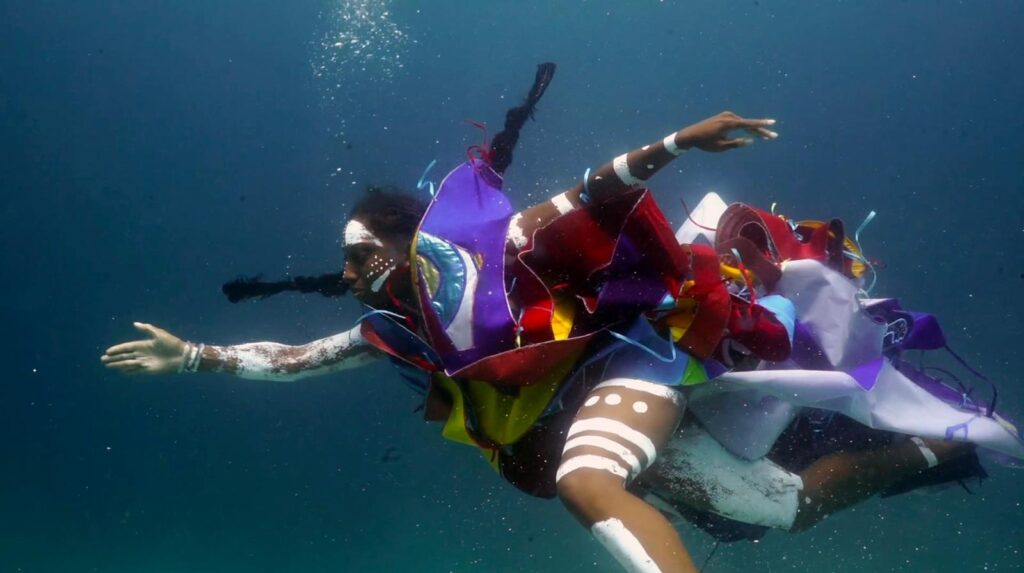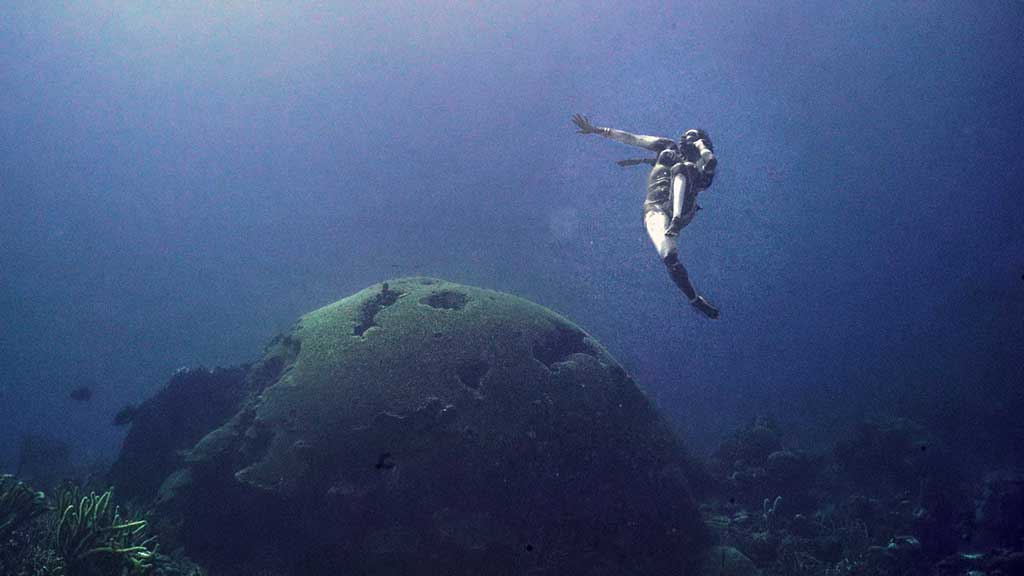
Nancy Nesvet

Courtesy of the Smithsonian Museum of Art
Artists are storytellers. We make up worlds, connections, visions of people and places, the best connected to who we are and our own personal history and beliefs. The fictions sprout from memories of what has been, who we and who those before us were, who we hope to become and our hopes and dreams and nightmares of the societies that might ensue. Some are audacious. Others allude to events, writings and performances that have gone before. Some recount histories and some express dreams. All are the products of creative minds, creating worlds of artists’ own making.
I once proposed a conceptual art project to Graham Campbell, the head of the Art Program at Brandeis University. At a crit, I would sit at the center of a circle of fellow art students and tell them about the beautiful painting I saw. Upon questioning as to where it was, I would answer that it was in my head, in my imagination. Graham replied with a strong “No”. To my questioning “Why Not”, he replied that it is the job of the visual artist to create something that people can see, something concrete, distinct from literature where the reader forms their own picture from the words of the author, so destroying my conceptual art project in one fell swoop.
In Venice, during the 2017 Venice Art Biennale, Damien Hirst, in his installation, Treasures from the Wreck of the Unbelievable created fictional artifacts, inventing a material culture for a civilization, named for a South African heavy metal band, and a story of its demise, in the sinking of a ship containing sculpture, statues, art, valuables, money and more from that fictionalized civilization. He then exhibited artifacts allegedly rescued from the sea floor and a film depicting the sunken ship attesting to its imagined existence, fulfilling his conception of the ship’s sinking, corroborating the story.
Borrowing from Samuel Beckett’s short play, “Krapp’s Last Tape”, Maurizio Catalan, exhibiting at Art Basel 2019, taped a banana to the wall. Undoubtedly inspired by Beckett’s concept, in Beckett’s play where Krapp speaks into a banana, substituting for a microphone with the only other prop a tape recorder documenting the actor’s failed career, Catalan’s project goes on to have a performance artist eat the banana, increasing the value of the installation manifold, but also underlining the installation as a performance, which is, of course, what Beckett’s play was. Importantly, as a visual artist, Catalan adapted Beckett’s words (and props) minimized to only concrete elements leaving the viewer to discover the connection to Beckett’s original concept. Both conceptually inspired works left me cold, as opposed to the work I recently saw at the Smithsonian African Art Museum by Ayana V. Jackson. Jackson has done it better. Her identification as an African-American woman and her impeccable research into a compendium of myths resulting in a personal myth of African and Caribbean culture produced a beautifully illustrated, convincing installation at the Smithsonian Museum of African Art in Washington, D.C., on view until the end of the year.

Courtesy of Mariane Ibrahim Gallery

Courtesy of the Smithsonian Museum of African Art
Born In New Jersey, resident in Brooklyn, Paris, and Johannesburg, adopted into her larger family in Accra, Ghana, the quadrilingual artist has researched fashion history, history of photography, Afrofuturist philosophy and African religions and myths to create this project fusing video, photography, anthropology and fashion, both creating the costumes she wears in photographic digital prints, and the story of the culture she has invented and illustrates. Introduced by a video screen of the sea’s gentle waves surrounding an African woman in the Atlantic Ocean, having survived a shipwreck of a vessel carrying pregnant women from Africa for enslavement in the Americas, Jackson proceeds to show us photographs of those women in dress adapted from sixteenth century African and French, British, Netherlandish, and Portugese origins.
According to her narrative, the pregnant women who walked through the sea began a civilization that traces its roots to Drexciya, a mid-Atlantic mythical nation first envisioned by 1990’s Detroit based techno-musicians, James Stinson and Gerald Donald. In Stinson’s and Donald’s version, enslaved African women jumped or were thrown from the slave ships into the sea. Ayana Jackson re-imagined a scenario where the surviving pregnant women were met by female water spirits who guided to birth a culture in the new Drexciya. Jackson’s extensive research led to consideration of pertinent myths and imagery of super-heroine deities including Mame Coumbabang of Senegal, Yemaya and Olokun of Nigeria, relating to Yoruba deities in the African diaspora and of Kianda of Angola, and spiritual beings including the Dogon Nomali of Mali, and Sangoma. Imagery of South African healers and priestesses and more from Ghana, Trinidad and Tobago, all with superpowers particular to each of the super deities and spiritual beings portrayed in the exhibited photographic prints added to the feminist viewpoint of the story.
While difficult to ignore the Christian comparison with Jesus walking upon water, a miracle, recounted in the New Testament, Jackson’s story seems possible. The materials accessed for costumes depicted in the photographs and paintings, fishing nets, spoons perhaps rescued from the ship, shredded plastic bags, reminiscent of those strangling our oceans today, seaweed, reeds indigenous to an island nation in the Caribbean or other island groups in the Americas fused with Elizabethan collars, rusting imperial crowns, wigs, here intricately braided, and other features of imperialist British, French, Portugese and Netherlandish dress, made from currently found materials in the sea and land, add to the believability of the story.

Courtesy of the Smithsonian Museum of Art
The gallery, with photographic portraits surrounding the viewer having entered through the room showing the video screen of the women walking through the water, appears like a gallery of family portraits in a sixteenth century British or European manor house. Aware of the possibility of the audience inferring exploitation in the use of portraits of others, Jackson photographs herself in the various costumes and persona, emphasizing that it is her history, her story. Walking from the bright light of the video’s sea, to the darkness enveloping the portraits and associated objects like flip flop rubber sandals, spoons, found mechanical parts, reflective beads approximating jewels, that might have washed ashore or been dumped into the sea, or textiles made from hemp or indigo plants sourced on the island testifies to the impression that this place could be anywhere, magnifying the fear and courage of those who walk to an unknown place to begin a newfound culture using objects and myths rescued from the civilization left behind. It is a testament to making stories live, through material culture and visual art. Ayana Jackson is not content however with visuals, adding sound. Jackson’s 2002 exhibition, That, and Full Circle: A Survey of Hip Hop in Ghana, was noted by the senior curator of her current exhibition, Karen E. Milbourne as having “revealed the artist’s ability to immerse herself in a community and tease out under-appreciated histories of Africa’s central position in global culture.” Jackson again uses this anthropological immersion in Drexciya. Jackson explains her extensive research and consequent melding of African myths and traditions to invent her own. She interviewed people who knew about Senegalese water spirits in diasporan literature and oral myths of spirits who midwifed pregnant women, capturing the babies in the ocean; the Yoruba pantheon and musical traditions of Nigeria, Haiti, Puerto Rico and Brazil, the Yoruba collector of bones and bodies. She researched the Angolan, Portugese and European mermaids or sirens, and adapted the appearance of the Origin mother, Quiandra, who reflected the twinkle of the moon of the sea at night, in the reflective beads in the costumes of those portrayed in the portraits and on the models. Jackson referred extensively to the Yoruba religions that traveled to the New World, that the women took “to the diaspora,” she narrates, and especially to the Yoruba river spirit that communes while walking with women in South Africa to a place where the sweet and saltwater meet, what we call brackish water.
Unlike the work of Hirst and Catalan, Jackson’s work is not a one-liner. It stems from research and personal investment in the traditions and history of a people that is her own, to which she belongs. Her grandfather was a follower of Marcus Garvey, famous for the Back to Africa movement, who bought and owned land in Accra, Ghana, and who sponsored relatives to come to the US. Within her family is Jerry Rawling who sought repatriation to Ghana. Jackson is a member of a family of three generations in Ghana, her adopted country. Hirst cannot claim this personal connection for the work portrayed, nor personal investment in its portrayal. Catalan is not honest about where his influence comes and does not understand the ramifications of that Beckett story to his personal history, if it exists. Graham Campbell is right. It is the job of the artist to make concrete the story, but that story is much better when there is research and a strong personal relation to its telling. Ayana Jackson has done it all.

